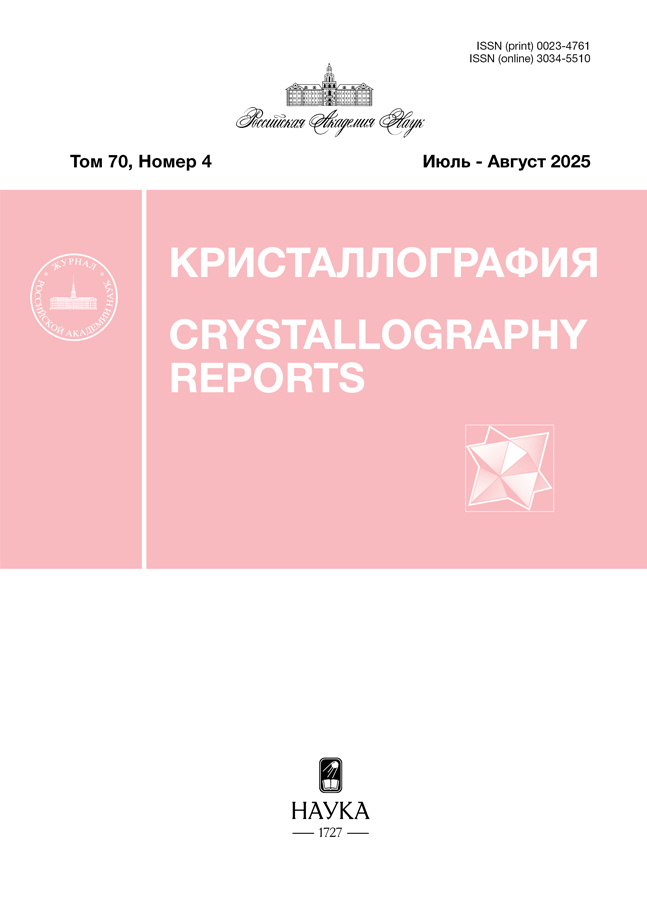Conductivity and real structure of cesium hydrosulphosphate crystals
- Authors: Gainutdinov R.V.1, Tolstikhina A.L.1, Makarova I.P.1, Komornikova V.A.1
-
Affiliations:
- Shubnikov Institute of Crystallography of Kurchatov complex “Crystallography and photonics” of NRC “Kurchatov institute”
- Issue: Vol 69, No 3 (2024)
- Pages: 470-475
- Section: ПОВЕРХНОСТЬ, ТОНКИЕ ПЛЕНКИ
- URL: https://transsyst.ru/0023-4761/article/view/673187
- DOI: https://doi.org/10.31857/S0023476124030129
- EDN: https://elibrary.ru/XOHMOZ
- ID: 673187
Cite item
Abstract
Superproton crystals obtained in the water-salt system CsHSO4–CsH2PO4–H2O were studied using electric atomic force microscopy. At 296 K for the Cs3(HSO4)2(H2PO4) and Cs4(HSO4)3(H2PO4) samples, local current-voltage characteristics were measured depending on the crystallographic orientation, the anisotropy of conductivity was established, and the degree of dependence of the conductive properties on the composition of the compounds was shown. Twin structures on cleavage fractures and their correlation with the atomic structure of monoclinic crystals are considered. The common features and differences in the atomic and real structure of mixed crystalline phases and the influence of hydrogen subsystems on their properties are discussed.
Full Text
About the authors
R. V. Gainutdinov
Shubnikov Institute of Crystallography of Kurchatov complex “Crystallography and photonics” of NRC “Kurchatov institute”
Email: alla@crys.ras.ru
Russian Federation, 119333 Moscow
A. L. Tolstikhina
Shubnikov Institute of Crystallography of Kurchatov complex “Crystallography and photonics” of NRC “Kurchatov institute”
Author for correspondence.
Email: alla@crys.ras.ru
Russian Federation, 119333 Moscow
I. P. Makarova
Shubnikov Institute of Crystallography of Kurchatov complex “Crystallography and photonics” of NRC “Kurchatov institute”
Email: alla@crys.ras.ru
Russian Federation, 119333 Moscow
V. A. Komornikova
Shubnikov Institute of Crystallography of Kurchatov complex “Crystallography and photonics” of NRC “Kurchatov institute”
Email: alla@crys.ras.ru
Russian Federation, 119333 Moscow
References
- Pawlaczyk Cz., Pawłowski A., Połomska M. et al. // Phase Transitions. 2010. V. 83. P. 854. http://dx.doi.org/10.1080/01411594.2010.509159
- Dupuis A.-C. // Prog. Mater. Sci. 2011. V. 56. P. 289. http://dx.doi.org/10.1016/j.pmatsci.2010.11.001
- Paschos O., Kunze J., Stimming U., Maglia F. // J. Phys.: Condens. Matter. 2011. V. 23. P. 234110. http://dx.doi.org/10.1088/0953-8984/23/23/234110
- Colomban P. // Solid State Ionics. 2019. V. 334. P. 125. https://www.researchgate.net/publication/331249475
- Ponomareva V., Lavrova G. // J. Solid State Electrochem. 2011. V. 15. P. 213. http://doi.org/10.1007/s10008-010-1227-1
- Коморников В.А., Гребенев В.В., Макарова И.П. и др. // Кристаллография. 2016. Т. 61. № 4. С. 645.https://doi.org/10.1134/S1063774516040106
- Makarova I., Grebenev V., Dmitricheva E. et al. // Acta Cryst. B. 2016. V. 72. P. 133. http://dx.doi.org/10.1107/S2052520615023069
- Makarova I., Selezneva E., Grebenev V. et al. // Ferroelectrics. 2016. V. 500. P. 54. https://doi.org/10.1080/00150193.2016.1215204
- Гайнутдинов Р.В., Толстихина А.Л., Селезнева Е.В., Макарова И.П. // ЖТФ. 2020. № 11. С. 1843. http://doi.org/10.21883/JTF.2020.11.49972.116-20
- Kalinin S., Dyck O., Balke N. et al. // ACS Nano. 2019. V. 13. № 9. P. 9735. https://doi.org/10.1021/acsnano.9b02687
- Kempaiah R., Vasudevamurthy G., Subramanian A. // Nano Energy. 2019. P. 103925. http://doi.org/10.1016/j.nanoen.2019.103925
- Louie M.W., Hightower A., Haile S.M. // ACS Nano. 2010. V. 4. № 5. P. 2811.
- Papandrew B., Li Q., Okatan M.B. et al. // Nanoscale. 2015. V. 7. P. 20089. http://doi.org/10.1039/c5nr04809e
- Mikheykin A.S., Chernyshov D.Yu., Makarova I.P. et al. // Solid State Ionics. 2017. V. 305. P. 30. https://doi.org/10.1016/j.ssi.2017.04.017
- Ройтбурд А.Л. // Успехи физ. наук. 1974. Т. 113. Вып. 1. С. 69. https://doi.org/10.3367/UFNr.0113.197405с.0069
- Бойко В.С., Гарбер Р.И., Косевич А.М. Обратимая пластичность кристаллов. М.: Наука, Глав. ред. физ.-мат. лит., 1991. 280 с.
- Остриков О.М. Механика двойникования твердых тел. Гомель: ГГТУ им. П.О. Сухого, 2008. 301 с.
- Gouveia R.F., Bernardes J.S., Ducati T.R.D., Galembeck F. // Anal. Chem. 2012. V. 84. № 23. P. 10191. https://doi.org/10.1021/ac3009753
- Bai X., Riet A., Xu S. et al. // J. Phys. Chem. C 2021. V. 125. P. 11677. https://doi.org/10.1021/acs.jpcc.1c02272
- Masuda H., Ishida N., Ogata Y. et al. // Nanoscale. 2017. V. 9. P. 893. http://doi.org/10.1039/c6nr07971g
- Zhu X., Revilla R.I., Hubin A. // J. Phys. Chem. C. 2018. V.122. № 50. P. 28556. https://doi.org/10.1021/acs.jpcc.8b10364
Supplementary files














